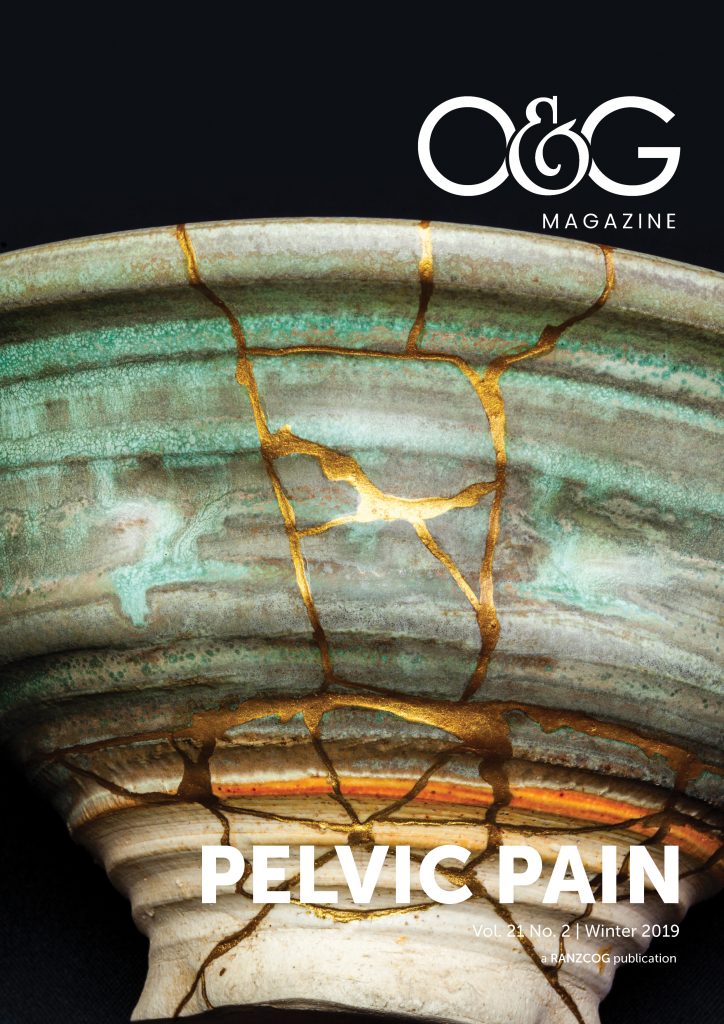With three placebo-controlled trials for the surgical treatment of endometriosis-associated pain, there is good evidence that surgery works to relieve pain symptoms.1 What those trials demonstrate, however, is both a placebo response of 30 per cent – common to all medical and surgical treatments when they are studied in this manner – and a nonresponse rate of approximately 20 per cent. These figures must be kept in mind when undertaking surgical treatments for endometriosis.
For any women presenting with pelvic pain symptoms, differential diagnoses must exclude life-threatening conditions often associated with pregnancy, with chronic pain symptoms more likely to be endometriosis – the commonest single diagnosis of chronic pelvic pain in women. There are increasing data to recommend clinical diagnosis based on history taking, thorough pelvic examination (where appropriate) and limited investigations, such as a pelvic ultrasound, with recognition that high-quality sonography has increasing sensitivity at discriminating small-volume disease on the uterosacral ligaments and bowel lesions, in addition to the traditional recognition of ovarian disease.2 It is early-stage disease that remains difficult to diagnose by sonography and serological studies are not helpful in making the diagnosis.
Medical options with simple analgesics and site-specific symptoms should be considered first line, with hormonal treatments demonstrated to be beneficial, although discontinuance of the oral contraceptive pill and progestogens may be as high as 50 per cent, owing to side effects.3 For women who do not tolerate these medications, have side effects associated with their use or have ongoing pain symptoms despite using them, surgery may be an option for management. The first question when considering surgery is ‘what is the expected outcome?’ Diagnostic procedures should not be considered in modern management of endometriosis as they increase the risk to the woman with no real benefit. The plan should always be a see-and-treat approach and it should be rare that the gynaecological surgeon is surprised by the findings at laparoscopy.
A surgeon’s insight into their own skillset is important. Investigation following a high index of suspicion of endometriosis based on history taking and clinical examination may reveal pelvic masses and a fixed, and often retroverted, uterus. This is an indication of high-stage disease and the surgeon must be comfortable undertaking sidewall and cul-de-sac dissection. Based on evidence, for any endometrioma there is a 99 per cent chance that there is sidewall disease,4 and, again the treatment of both the endometrioma and the sidewall disease must be the preoperative aim and the surgeon must have this in their skillset (minimum RANZCOG-AGES level 4 procedure, with possibility of level 5 or 6 skills being required5) before they undertake the procedure. Even without the much-discussed deep invasive endometriosis ultrasound, a good 2D scan and clinical examination will be able to guide direction for the degree of difficulty in most surgical situations. Where a deep infiltrating endometriosis (DIE) scan is available (and affordable), this offers outstanding mapping of the pelvic disease, often informs when additional staff, such as colorectal colleagues or urologists, may be needed to contribute to the procedure and allows more tailored counselling and consenting of women preoperatively.
Many cases of endometriosis are not in the moderate–severe stage, which presents with deeply infiltrating lesions and the involvement of ovary, bowel, bladder or ureter. Peritoneal disease or deep disease affecting the uterosacral ligaments, cul-de-sac or sidewalls is common and an approach to treatment is required. There has been considerable debate over ablation versus excision and the simple fact is that it is likely to make no difference which technique you use, as long as the lesions are removed in toto. Ablation (better named vapourisation, since this is actually the effect that is desirable) is perfectly reasonable and can be carried out using standard electrosurgical electrode (such as scissors or needlepoint) and an electrosurgical generator. Vapourising the lesion with a low-power continuous waveform current will remove the lesion with minimal thermal spread and damage to surrounding tissue that may induce cicatrisation and neuropathic sensitisation. Vapourisation of deep lesions is also perfectly reasonable but requires an understanding of the potential anatomical structures that may be injured in proximity to the lesion, and carbonisation of the tissues must be avoided since this leads to superficial insulation and an increased risk of unintended thermal injury. The technique of vapourisation does not allow for histological assessment of the abnormal tissue and it is well documented that not all lesions that are considered to be endometriosis are this disease. This is important, since while there is a definite recurrence rate with endometriosis, which may respond to a second surgical procedure; where there is no endometriosis, recurrence of symptoms and subsequent surgery may not improve the situation and, in fact, may exacerbate the problem.
Excisional surgery does allow for both histological assessment of the tissues and to gauge the depth of the lesion. The surgical principles of traction-countertraction may be readily employed with dissection of non-involved anatomical structures away from the lesion to preserve their function and prevent unintended injury. The instruments required for excision are exactly the same as for ablation, with an electrosurgical generator and an electrode (such as laparoscopic scissors) readily and inexpensively available wherever surgery is undertaken. For disease that involves the ovaries, it is imperative that not only is the ovarian disease treated, but so too is the sidewall disease removed since persistence does not allow for an adequate surgical response to be evaluated. It is also easiest to do this at the primary surgery, rather than subsequent surgery when ovarian adhesions necessitate further ovarian dissection to allow access to sidewall disease that can deplete ovarian follicular reserve and volume reduce the ovary. As a general principle, it should be considered that ‘the first go is the best go’ with respect of removing disease and all subsequent surgeries for endometriosis are higher risk, since the fibrosis that may be associated with previous surgical excision is difficult to distinguish from fibrosis associated with recurrent (or persistent) disease and surgical risk is increased in these cases.
Even with the very best surgical treatments and removal of all lesions in the pelvis, symptom recurrence for pain is approximately 50 per cent at five years (although actual disease recurrence is not always present) and re-assessment and evaluation is mandatory in this situation. Consideration of hormonal treatments, analgesic and neuroleptic medications, evaluation and treatment of muscular involvement by a skilled physiotherapist when appropriate, alongside simple self-management strategies for the woman including local heat, meditation, yoga and exercise may all offer benefit. Any subsequent surgery must be considered higher risk for complication and histology in this setting should be considered mandatory. Scheduled surgery in the asymptomatic woman to ‘check up’ on disease offers no benefit, carries risk and should not be undertaken. Evaluation as per first surgery with history, examination and sonography is good practice, and referral to centres or surgeons skilled in both the surgical and medical management of endometriosis and pain is appropriate where the primary surgeon is unfamiliar with the range of options or not confident in the increasingly complex surgical pelvis in this situation.
Women often ask how long their disease has been present, but there is no way of knowing this based on surgery. Progression is usually quite slow, with studies suggesting that no progression–minimal progression in two years is apparent for 80 per cent of women. For a small number of women, progression may be very rapid (as may recurrence). It is unclear as to the triggers for this and we have no way of currently identifying this group of women, although that would be helpful since it may improve counselling and consent. The endometriosis fertility index (EFI) is a surgically based and validated assessment tool that has prognostic implications for subsequent pregnancy and may also guide whether expectant management or IVF should be the recommendation post-operatively for women desiring pregnancy.6 Photodocumentation should be a mandatory part of the procedure, since this may also aid in fertility counselling and EFI evaluation. Furthermore, given the range of disease presentations, the potential for further surgery and the risks associated with any subsequent procedure, pre-operative planning will be more readily facilitated by photographic evidence to determine recurrent versus new disease and for prognostic discussions with the woman.
With some 16,000 primary surgeries for endometriosis and the same number of secondary surgeries, this is a common procedure commensurate with the prevalence of the disease. The National Action Plan for endometriosis7 has clinical care as one of its three foundation pillars and includes the recommendation of clinical care pathways for women with suspected endometriosis. Large-scale national research studies via the MRFF-funded National Endometriosis Clinical and Scientific (NECST) network8 will further improve our knowledge in the area of the surgical management of women with endometriosis and contribute to improving the quality of life of some 10 per cent of women living with this disease globally.
References
- Abbott J. Surgical Therapies: Randomized Controlled Trials in Endometriosis. Endometriosis: Science and Practice. Blackwell Publishing Ltd. 2012. p.410-18. DOI:10.1002/9781444398519.
- Taylor HS, Adamson GD, Diamond MP, et al. An evidence-based approach to assessing clinical diagnosis of symptomatic endometriosis. International Journal of Gynaecology & Obstetrics. 2018;142(2):131-142.
- Brown J, Farquhar C. Endometriosis: an overview of Cochrane Reviews. Cochrane Database Syst Rev. 2014(3):CD009590.
- Redwine DB. Ovarian endometriosis: a marker for more extensive pelvic and intestinal disease. Fertility & Sterility. 1999;72(2):310-5.
- RANZCOG. Guidelines for performing gynaecological endoscopic procedures. 2018. Available from: https://www.ranzcog.edu.au/Statements-Guidelines/Training/Advanced-Operative-Laparoscopy,-Guidelines-for-Per.
- GD Adamson, DJ Pasta. Endometriosis fertility index: the new, validated endometriosis staging system. Fertil Steril. 2010;94:1609-15.
- Department of Health. National Action Plan for Endometriosis. 2018. Available from: www.health.gov.au/internet/main/publishing.nsf/Content/endometriosis.
- Jean Hailes. The National Endometriosis Clinical and Scientific Trials (NECST) Network. 2019. Available from: https://jeanhailes.org.au/necst.






Leave a Reply